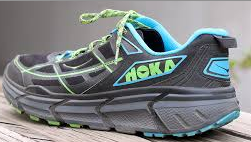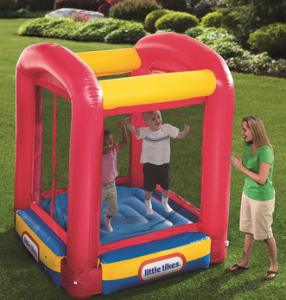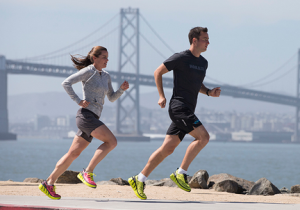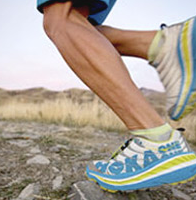by Bill Katovsky
Cush·ion-ism ˈko͝o SHən izəm: Belief system by runners who prefer running in shoes with built-up footbed support, yet health claims and injury prevention remain unsupported due to the absence of scientific evidence.
Cushionism first entered the vocabulary of runners in late 2010, when two Frenchmen, Nicolas Mermoud and Jean-Luc Diard, both former Salomon employees, launched Hoka One One, a strange name for an even stranger looking running shoe. The thickly-padded, relatively flat-soled shoes were named after a phrase used by the Maoris of New Zealand, meaning “flying over the earth.”
The Maori term for clown is “hangareka,” and the shoe would have probably achieved the same level of commercial success had it been named Hangareka One One. In fact, it is easy to argue that a shoe with a circus-related name might have been even more relevant. For the cartoony shoe augured in the new era of maximalism, and how fitting and cool would it have been to pay historical homage to The Circus Maximus, which was the largest stadium in ancient Rome. Popular chariot races were held here for almost a millennium.
 Judging from the reaction by runners today, many of them ultra runners, they think these ultra-cushioned shoes will let them run for a millennium. According to these runners, the additional padding reduces leg fatigue and stress from repetitive footstrike impact, especially on rocky trails; makes it easier to recover from a leg injury and continuing running; and allows them to do what the human body wasn’t naturally designed to do: Run too far and too fast. (Chasing a wildebeest for dinner over eight hours of slow running or loping is not the same as running the Western States 100 under 24 hours, and for the leaders, many hours faster.)
Judging from the reaction by runners today, many of them ultra runners, they think these ultra-cushioned shoes will let them run for a millennium. According to these runners, the additional padding reduces leg fatigue and stress from repetitive footstrike impact, especially on rocky trails; makes it easier to recover from a leg injury and continuing running; and allows them to do what the human body wasn’t naturally designed to do: Run too far and too fast. (Chasing a wildebeest for dinner over eight hours of slow running or loping is not the same as running the Western States 100 under 24 hours, and for the leaders, many hours faster.)
When looking up the definition of “cushion” in the The Free Dictionary, the three primary meanings are: 1.) A pad or pillow with a soft filling; 2.) Something resilient used as a rest, support, or shock absorber; and 3.) A mat placed or attached beneath carpeting to provide softness and increase durability. The Hoka One One satisfied all three meanings for cushioning (saying the shoe brand out loud conjures up the image of a habitually injured ultra runner shouting, “Don’t call 911, call Hoka One One!”). This is not to suggest you want to trade in the pillow you sleep on for a Hoka head rest.
The extra cushioning is also called stack height. The Hoka boasted the greatest height in the shoe world. For awhile anyway, it was the Empire State Building of Stack Height. But the cushioning was made with a strong enough material that while it functioned as a shock absorber for the legs, the sole wasn’t Pillsbury Doughboy-like soft. There was some give to the cushioning support, but the real take away is how quickly Hoka and its copycat fat brethren pushed aside the 99-pound weakling known as minimalism.

Minimalism came of age right around the time Christopher McDougall’s “Born to Run” hit the New York Times bestseller list, remained there for over a year, and changed the running shoe industry (Okay, a small percentage of it, but one that garnered an exceptional amount of press.) Minimalism or barefoot-lifestyle shoes ranged from the truly odd-shaped Vibram FiveFingers to huaraches such as Xero Shoes and Shamma Sandals to Altras to Merrell’s Trail Gloves. A minimalist shoe had almost no stack height (at least in the beginning), no height differential between the heel and toe box, and scant midsole cushioning.
 As the fat-and-flat maximalist shoes attracted new converts and formerly broken-down aging runners, the minimalist sector in the running shoe marketplace took the biggest hit. (We shouldn’t forget that 95 percent of all runners have run, and will continue to run in conventional shoes with large, oversized heels, and rigid, stabilizing design; there’s also a significant differential between the heel and toe area. Heel-striking is a common effect of traditional shoes, whereas minimalism promoted a more natural midfoot landing.
As the fat-and-flat maximalist shoes attracted new converts and formerly broken-down aging runners, the minimalist sector in the running shoe marketplace took the biggest hit. (We shouldn’t forget that 95 percent of all runners have run, and will continue to run in conventional shoes with large, oversized heels, and rigid, stabilizing design; there’s also a significant differential between the heel and toe area. Heel-striking is a common effect of traditional shoes, whereas minimalism promoted a more natural midfoot landing.
Maximalism took from minimalism one of its key attributes—the zero drop, or heel-toe differential—and squashed “less shoe” like a June bug. Go to an outdoor industry trade show these days, and count the exhibitors hawking minimalist running shoes. (You won’t find many.) Now scan the carpeted aisles for fat, flat and flashy maximalist running shoes. It’s a cornucopia of cushioning.
Cushionism, however, is not the same as cushioning. You can have a small or moderate amount of cushioning in a shoe and still not be stepping inside the maximalist camp. By contrast, cushionism is the irrational, untested, and non-empirical belief that all that extra cushion is unconditionally good for you, that it allows runners to keep running when common sense suggests otherwise because leg fatigue is masked. Over the long term, cushionism just might lead to the body breaking down and subsequent injuries. It’s too early to tell at the present. Do runners want to gamble with their own future?


Steven some stuff on my store page
http://tworiverstreads.com/simple-food-rules/
also google anything by Steve Phinney or Jeff Volek
Mark
Mark